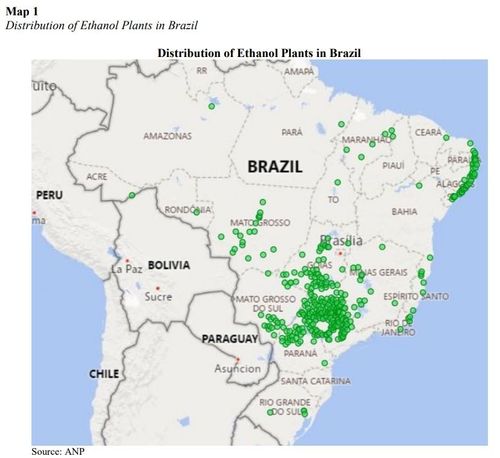Report Predicts 7% Increase In Brazilian Ethanol Production This Year

Ethanol production in Brazil is expected to increase by 7 percent this year due to an increase in sugarcane production and a continued steady increase in corn ethanol production, according to a report filed with the USDA Foreign Agricultural Service’s Global Agricultural Information Network.
The report estimates that Brazil currently has 351 first-generation ethanol production facilities, including 333 that process only sugarcane feedstock and 18 that process only corn or are designed to process both feedstocks. The country also has two cellulosic ethanol plants.
The number of sugarcane processing facilities has decreased in recent years from a high of 384 facilities in 2017, to 347 facilities in 2020, 343 facilities and 2021 and 337 facilities in 2022. Total nameplate capacity of sugarcane ethanol plants has risen despite that decrease, from 50.5 billion liters (13.34 billion gallons) in 2021, to 54.28 billion liters in 2022 and 54.8 billion liters in 2023.
The number of plants that process corn or both corn and sugarcane is at 18 currently, up from 17 in 2022, but down from 19 in 2020. Nameplate capacity at these facilities is expected to reach 5.2 billion liters this year, up from 5 billion liters last year and 4 billion gallons in 2021. Capacity use at these facilities is expected to be at 52 percent this year, compared to 50 percent last year.
Brazil had three cellulosic ethanol plants as of 2021, that number fell to two facilities last year and is expected to remain at that level this year. Nameplate capacity is currently at 70 million liters, down from 75 million liters in both 2021 and 2022. Cellulosic facilities are expected to operate at 53 percent capacity this year, compared to 51 percent capacity last year.
According to the report, a wheat ethanol plant is also under development in Brazil and expected to begin operations in 2024. That facility, located in Rio Grande do Sul, is expected to have an annual capacity of 111 million liters.
Total ethanol production in Brazil is expected to reach 32.95 billion liters this year, including 29.965 billion liters of fuel ethanol and 51 million liters of cellulosic ethanol. Production was at 30.746 billion liters last year, including 27.6 billion liters of fuel ethanol and 53 million liters of cellulosic ethanol, and at 29.98 billion liters in 2021, including 26.195 billion liters of fuel ethanol and 40 million liters of cellulosic ethanol.
Brazil is expected to import 405 million liters of ethanol this year, including 400 million liters of fuel ethanol. Imports were at 322 million liters last year, including 316 million liters of fuel ethanol, and at 432 million liters in 2021, including 427 million liters of fuel ethanol.
The U.S. was the top source of Brazil’s ethanol imports last year at 212.33 million liters, followed by Paraguay at 103.21 million liters, and Canada at 137,000 liters.
Bazil is currently expected to export 2.205 billion liters of ethanol this year, including 315 million liters of fuel ethanol. Exports were at 2.445 billion liters last year, including 320 million liters of fuel ethanol, and at 1.948 billion liters in 2021, including 300 million liters of fuel ethanol.
In 2022, South Korea was the top destination for Brazian ethanol exports, at 739.54 million liters, followed by the Netherlands at 710.87 million liters and the U.S. 461.98 million liters.
Total ethanol consumption in Brazil is expected to reach 31.75 billion liters in 2023, up from 29.7 billion liters in 2022 and 29.545 billion liters in 2021. Fuel ethanol consumption was at 27.408 billion liters in 2021, increasing to 27.6 billion liters in 2022 and is expected to reach 29.6 billion liters this year.
The overall ethanol blend rate in Brazil is expected to be at 47.5 percent this year, compared to 46.8 percent last year, 48.8 percent in 2021 and 52.5 percent in 2020.
A full copy of the report is available on the USDA FAS GAIN website.















